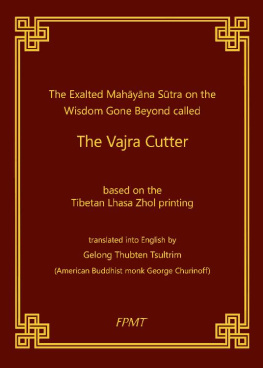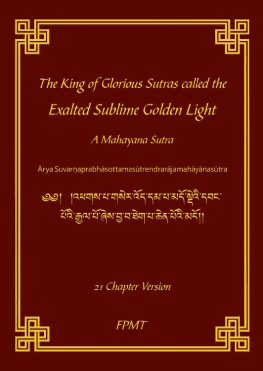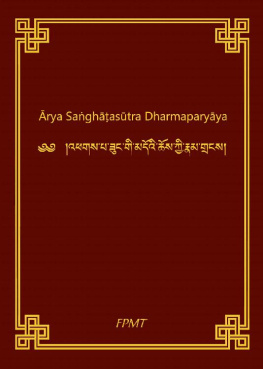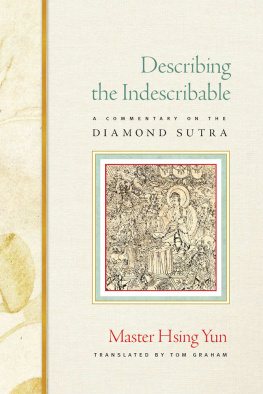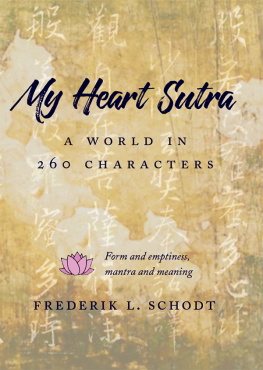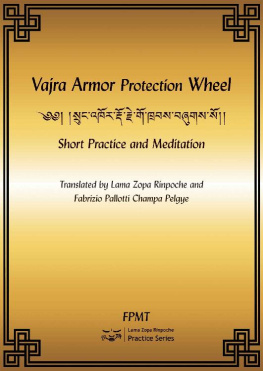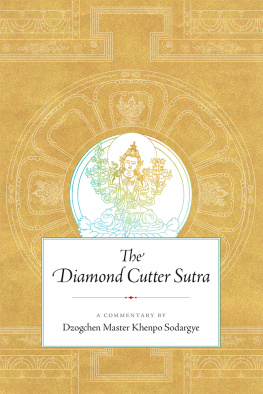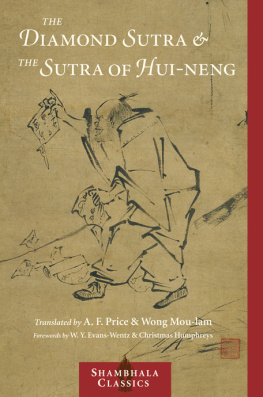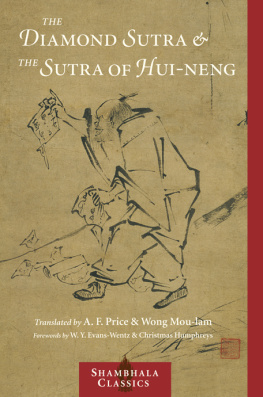We offer to read an annotation, description, summary or preface (depends on what the author of the book "The Exalted Mahayana Sutra on the Wisdom Gone Beyond Called the Vajra Cutter based on the Tibetan Lhasa Zhol Printing" wrote himself). If you haven't found the necessary information about the book — write in the comments, we will try to find it.
Vajra Cutter Sutra (The Exalted Mahayana Sutra on the Wisdom Gone Beyond called The Vajra Cutter) contains teachings by the Buddha on the Perfection of Wisdom. Reciting this sutra purifies mountains of negative karma, clears away obstacles to the success of virtuous activities, and plants seeds to realize emptiness directly. Lama Zopa Rinpoche advises to recite the Dedication Prayer by Mipham Rinpoche following recitation or reading of the Vajra Cutter Sutra.The Vajra Cutter Sutra (also known as Diamond Cutter Sutra or Diamond Sutra) is one of most well-known sutras of Mahayana Buddhism. The Vajra Cutter Sutra is a discourse on the Buddhist concept of emptiness, the wisdom gone beyond. Dedication Prayer by Mipham RinpocheDedication Prayer after Reading the Diamond Cutter SutraTranslation and footnotes by Lama Thubten Zopa RinpocheDedication VersesIn this world, with its devas, to the founder who, with the roaring sound of asnow lion, proclaimed the talk of dependently connected arising,i Irespectfully prostrate.The son of the king, abiding majestically in the temple in the midst of anassembly of virtue beggars (bhikshu, ge.long) and those intending virtue(ge.dun),ii handed over this Dharma to the holy holder of Dharma, Kungawo(attendant Ananda) with great emphasis (great care) proclaiming the definitemeaning with the defining words, Even if all the Dharma is forgotten, dontforget this one.It is said by Buddha that writing or reading one word of the Prajnaparamitahas greater benefit than making offerings to all the buddhas for 1000 tenmillion eons.iiiWhy is it like that? The only remedy extremely powerful in (directly) cuttingthe root of all the mistakes of the world (samsara), ignorance, is this holyDharma, the Dharma supreme of all the teachings, the ultimate heart ofPrajnaparamita (Wisdom Gone Beyond.)ivHaving written, read and made offerings to the supreme Dharma of all the(Buddhas) teachings, the heart of Prajnaparamita (Wisdom Gone Beyond),the ultimate one, the sutra called Diamond Cutter, may it cut the continuityof the sickness and harms of black magic, evil si (possession by an evilspirit)v, obstacles (astrological) and so forth, and increase the life and wealth;may whatever wishes spontaneously be accomplished according to holyDharma.viDue to the merits and imprint of having listened to this Sutra and havingread it at this time, in all future lifetimes may I and all sentient beings whohave connection with me be able to hear, reflect and meditate on thisprofound Sutra.viiMay I become exactly like the life-stories of Sharipu and Muadiglyana: theminute one hears the words and meaning (of the Prajnaparamita DiamondCutter Sutra) able to have the words and meaning within onesunderstanding and achieve the result. viii2By the virtue of having read this profound Sutra, may I directly perceive thetruth and liberate in that second all transmigratory beings, equaling the sky,from the great ocean of samsaric suffering.ixNot grasping at just mere emptinessx by seeing that the meaning ofemptiness is dependent arisingwhile the mind is in that emptiness, freefrom creativity (mental fabrication projecting true existence), enjoy the viewof emptiness-only.xiAscertain that the various appearances,xii the dual dharma,xiii are mereappearance.xiv May I realize emptiness while there is appearance, with thethought, even though there is appearance it is not true (truly existent.)By the eminent heart wisdom,xv without abiding in the extremes of samsaraand peace, quickly proceeding on the five paths, may I become the guide(leader) of all the transmigratory beings.xviBy this particular virtue, and all (other) virtues, may the gurus holy lives bestable and all the deeds and actions of the victorious ones be accomplishedby myself, alone.May this holy Dharma, for which the founder (Guru Shakyamuni Buddha),while training in the path, gave up the holy body and all enjoyments andpossessions, and accomplished the work only for sentient beings, last a longtime.The victorious one gave up lying for numberless eons even at the cost of thelife and spoke truthfully; by that blessing may all the prayers beaccomplished.xvii***********These prayer words, related to Diamond Cutter Sutra, were composed by Mipham Dawa. I amnot familiar with this author but the words are extremely profound.After this one can recite the Diamond Cutter Sutra mantra.NAMO BHAGAWATI/ PRAGYA PARAMITAYE/ OM NA TA TATITHA/ ILISHI ILISHI MILISHI MILISHIBINAYAN BINAYAN / NAMO BHAGAWATI PRATAYANG PRATI/ IRIDHI/ IRIDHI/ MIRIDHI/ MIRIDHI/SHIRIDHI/ SHIRIDHI/ USHIRI/ USHIRI/ BUIYE/ BUIYE SWAHAThe benefit of reciting the heart of the Diamond Cutter Sutra equals having recited the DiamondCutter Sutra 9x3000 times. 3Then recite the mantra of dependent arising and Vajrasattva mantra. Also, after reciting theDiamond Cutter Sutra it is good to do the mantras for increasing merits.May the merit of having translated this work bring the most benefit to and be used by all sentientbeings, causing them to quickly realize emptiness and then with direct perception, bodhicitta,achieve full enlightenment as quickly as possible. May it cause all sentient beings in this worldto be able to read the Diamond Cutter Sutra, realize emptiness and actualize bodhicitta, realizingother sentient beings suffering and how they are so precious. May nobody experience war,famine, disease or danger from fire, water, wind and earthquakes.Whoever reads this dedication, may all their negative karma get purified and may they never getreborn in the lower realms. May they immediately realize emptiness, actualize bodhicitta,complete the two stages of tantra in this very life and achieve enlightenment as quickly aspossible. May each person who reads this dedication become the source of peace and happinessfor all sentient beings, like Chenrezig, like Guru Shakyamuni Buddha, like Maitreya Buddha,Vajrapani and Manjushri.May the wishes of whoever recites the Diamond Cutter Sutra succeed immediately, may theyhave a long life and receive all the benefits, whatever they wish.Kachoe Dechen LingJanuary 24, 2005Scribe/transcriber Thubten LabdronLightly edited by Thubten LabdronNotes i Tib: ten.ching del.wai jung.wa. Ten depending; del connecting; jung arising.Things arise and come into existence by depending on the base, the mind.ii The virtue they are begging (Tib. ge.long) is liberation or nirvana, and because they are seekingthat, they are living in the vow. The other one is intending virtue (Tib. ge.dun; ge - virtue, dun -intending.) For that reason they have the wish to live in virtue.iii 10x100,000 = 1 sa.ya. 10 sa.ya = 1 che.wa (10,000,000.) The result of making one offering toa picture or statue of Buddha includes all the happiness of samsara we have had sincebeginningless time and all the samsaric pleasures we will experience in the future. Not only that,the benefit continues as one achieves liberation from samsara, all the realizations, and doesntfinish until one achieves great liberation, enlightenment. That includes the complete Mahayanapath from guru devotion, renunciation of this and future lives, then bodhicitta, right view, thefive paths and ten bhumis, and the tantric path. It includes the limitless qualities of Buddhasholy body, holy speech and holy mind. Everything is the result of having made a tiny offering of 4one grain, a stick of incense or a tiny flower to Buddha or an image of Buddha, a stupa orscripture.The text mentions liberation, which means great liberation, but my view is that even after youachieve enlightenment still you experience the benefits of making that tiny offering, because thenyou liberate numberless sentient beings by revealing Dharma. Through suitable means youliberate one sentient being from the lower realms, from the suffering of samsara, from lowernirvana and from the subtle defilements; then you bring that sentient being to enlightenment.Like that you bring numberless sentient beings from happiness to happiness to fullenlightenment. So even after you achieve great liberation, there are all these unimaginablebenefits of guiding each of the numberless sentient beings from happiness to happiness to fullenlightenment; still you are experiencing the resultant merit of offering a tiny flower or grain to astatue, stupa or scripture. The benefit is the same when we make offering before we drink or eat.So the benefit of making offerings to Buddha, even a picture or statue of Buddha, is limitless, itincludes everything, all the happiness and every single realization on the path to enlightenment,every single samsaric pleasure that one has experienced from beginningless rebirth up to nowand will experience in the future; for that long, still the merit doesnt finish. Here it says, forhowever long you make offerings to Buddha, even 1000 times ten million eons, even to all thebuddhas, writing or reading one word of the Prajnaparamita has greater benefit.iv Neither bodhicitta nor any other realization of sutra and tantra can directly cut ignorance.v Tib: si, a being who, with an evil mind harmed others in a previous life. I think maybe si issomebody who criticized or broke the relationship with the vajra master; who created very heavynegative karma and died with hatred, then was reborn as a powerful spirit that harms holy beingsor those sentient beings who preserve and spread the Dharma.vi Only bodhisattvas living in the 8th, 9th and 10th bhumi dont have delusions, so I addedaccording to holy Dharma to protect from the danger of someone dedicating for the success ofharmful negative thoughts, like wishing someone to die, etc.vii At the beginning this text tells how much Buddha cherished and emphasized the preciousnessof this sutra and how Buddha handed this teaching precisely to Ananda. Then it talks about howit collects incredible merit; how offering to Buddha is incredible, like limitless sky, bringingbenefits beyond our imagination and yet how having written or read even one word ofPrajnaparamita has much greater benefits. It then explains how the Prajnaparamita benefits bybeing the only one powerful enough to cut the root of suffering, from where delusions and karmacome, and other benefits. Then it tells why it is the only remedy powerful enough to cut the rootof all the suffering, delusions, karma and ignorance. Then it talks about other benefits likestopping heavy problems such as black magic, astrological obstacle years and the evil si spirit,and increasing life and wealth.So it talked about pacifying, then about increasing life, wealth and enjoyments, and for all wishesto spontaneously succeed. 5Then the next one is making prayers to be able to hear it in all future lifetimes. Here, I added, sothat you are not doing the prayer and dedicating the merits only for yourself, I and allsentient beings who have connection with me, in all future lifetimes be able to hear Then Iadded reflect and meditate on this sutra.viii One is able to understand the vast Prajnaparamita; just as many things can be packed inside asmall container or suitcase, the minute one hears Prajnaparamita Diamond Cutter Sutra, one isable to have the complete words and meanings within ones understanding.ix I added this dedication.x This has a very profound meaning. Grasping at mere emptiness refers to ordinary emptiness,like space. When you meditate, if it didnt touch the hallucinated object, the object to be refuted,that would be ordinary emptiness. Then the whole life you would be meditating on ordinaryemptiness, meditating on the sky, like looking from an airplane window at space.xi In Tibetan emptiness only is tong-nyi. Tong is emptiness nyi is only. Why not just tong?Why is nyi added? Putting the word nyi makes a huge difference, it gives incredible protectionby cutting the misconception of ordinary emptiness; it gives the meaning of ultimate truth.xii The various appearances means everything, all the billions of things here, in the departmentstores or supermarkets. They are all dual appearance or dual dharma.xiii One meaning of dual dharma is true existence; another meaning is appearing as subject andobject. When arya beings are in equipoise meditation on emptiness there is no duality, there is nosubject/object in the view of that mind. The dual view is not cut at that time but absorbed. Onlywhen you become enlightened, when the subtle negative imprint left by the concept of trueexistence, which projects the truly existent view, is ceased, is the dualistic view cut. During thepath of the arya being it is not cut but temporarily absorbed, like having put water into water.I think what it is saying is that one has to meditate on merely labeled, like the example of amirage. You look at the things that happen in everyday life as like an illusion or a dream, withyour meditative awareness that there is no such thing in reality, everything is empty. Whateverappears to us here, right nowI appear to you, you appear to me, whatever appears to our sixsensesthe way they appear is not as phenomena merely labeled by mind, but as existing fromtheir own side. When you are practicing mindfulness you see how all this is merely labeled bymind or like a dream, an illusion or a mirage.When you apply those examples to everyday life, the understanding that comes in your heart isthat all this is not true. There is no such subject I, there is no such action, objectthere is nosuch thing. So its a totally different world. The reality, what exists, is completely another world.When you dont meditate or practice mindfulness, the mind believes as true all the hallucinationsthat appear truly existent. But the reality is completely opposite: everything existing from its ownside and believed as such, is completely non-existent. That is the truth, the other one is false. The 6way things appear to ussubject, action, objectand is believed by our own mind to be real, isall hallucination.What exists is that non-existence. The reality, that nothing exists from its own side, is unknown.The non-existent, truly-existent I, action and object are the reality. For those who have realizedemptiness or see things as illusory, perhaps it is different, but otherwise the reality is unknown.What is believed according to our concepts doesnt exist; what one doesnt believe or what is notknown is what exists.xiv All phenomena are merely imputed by mind on mere appearance. You have to get that idea.First there is mere appearance and then mind merely imputes on that and that is how things comeinto existence. If something is appearing as truly existent then it is not mere appearance. Afterbeing merely labeled it should appear back as a mere appearance, but when it appears back to usthere is something additional, existing from its own side. When it appears back as merely labeledby mind, then it is mere appearance. That is the correct view, what it should be.Here it says ascertain mere appearance. Another way you can say it is ascertain as merelylabeled by mind. It has the same meaning.For example, Pabongkha Rinpoche also mentioned in the teachings when you look at a drum andtry to be aware that this drum is merely imputed by ones own mind, not just saying the wordsbut meditating, you see the base, the shape and the functionbeating to make a noiseand byreason of that that the mind merely imputed drum.At that time if you are watching the mind as it merely imputes drum there is a very subtlemoment of mere appearance, a very short second, then immediately after that it appears asexisting from its own side.For example, after you conceive a child, you think about a name. If your mind is aware, at thevery first moment when your mind merely imputed a name, during the very second you arelabeling, there will be a mere appearance, when there is not a strong clinging to that Peter orTashi. But its a very, very subtle moment; if you are not aware, of course, it looks likeimmediately truly existent Tashi or Peter.I dont know whether you can say there is an extremely subtle true existence, but right after yourmind merely imputed, because of habituation, the negative imprint left on the mental continuumby the past ignorance, the concept holding true existence, immediately projects truly existenton that. That is the evolution. There might be a second where it doesnt have heavy trueexistence; right after the parents said What about Peter? Lets decide on Peter. This isPeter, while they are aware of labeling, merely imputing; but when you are not aware, you dontnotice that extremely short second. You have to analyze.There may be some cases when you put this name for a few seconds, then the next minute youchange that nameduring that time how does it appear? Its good to check how it appears toyou. Does it appear as something very heavy truly existent or not? Pabongkha Rinpoche did 7express that there is a very, very short time of mere appearance and then the usual one, trueexistence.When you look through the window at the road, there is, for example, a horses body runningand on that particular appearance, you label horse running. Or a cat jumpson the suddenmere appearance of that particular bodily shape the mind labels cat jumping.A particular design is called bicycle. It appeared and in a finger-snap your mind made up thelabel bicycle. Then you see a particular vehicle and because of that your mind immediatelyimputes truck.If you dont meditate, what happens then is that they appear as truly existent truck, truly existentbicycle, truly existent cat and dog and horse and all these different thingseven though just nowyour mind merely imputed. The reality is what your mind merely imputed appears back as amere appearance.I think mere appearance should cut truly existent, appearing as heavily existing from its ownside. In merely labeled, merely cuts existing from its own side, so mere appearance is thesameit cuts that extra thing, not just mere appearance but truly existent appearance.So if you practice awareness from the beginning, when your mind imputes, and continue thatawareness, then you see that because the base is there, your mind merely imputed and believed inthat.What is horse? It is not something on that horse body; horse is just a name made up by yourthought, and you believe in that. And bicycle, seeing that base your mind thought of the labeland believed in it. It is not something on the bicycle, on that material. If you analyze it, this ishow it is. When you dont check, dont analyze, it looks like it is really there, on the base; whenyou analyze you cannot find it there. At that time it exists and receives the label according to thebase and function. If a persons body is very fat and square, we say such-and-such person is fatand square. If the persons body is very thin, this person is very thin. So the label is receivedaccording to the function or quality of that base.The conclusion is we have to meditate according to the reality that whatever it is, it is merelyimputed by ones own mind. Whatever appears to you as truly existent is in reality mereappearance.The other meaning of mere appearance could be like having walked through sand, lookingback you see an appearance of water but you just came from there and you know there is nowater at all. You have a mere appearance of water but you dont believe there is water. Similarly,everything appears to us as not merely labeled by mind, as existing from its own side. Onemeaning could be like that.When you meditate in sitting meditation or break time, looking at everything as like a dream, anillusion or, if you are practicing subtle dependent arising, merely labeled, you have an 8appearance of true existence but you dont believe it. Because your mind is aware that it ismerely labeled, you dont cling or grasp to that truly existent appearance as true. Just like whenyou recognize a dream as a dream, you dont cling to all those images that are appearing to youbecause while it is happening you know it is a dream.So mere appearance could have the meaning that you have a truly existent appearance but youdont hold on to it or grasp it as true. Another meaning is, after you have done analysis of the I,you see it is merely labeled by mind. I exists in mere name. There is no I to be found on theaggregates but there is I existing, merely imputed by mind. In other words there is a non-trulyexistent or merely labeled I. Because there are the aggregates so there is I, existing in merename. It is not that it absolutely doesnt exist it exists as something extremely, unbelievablysubtle.Similarly, when you analyze the general aggregates you cannot find them on this collection offive, but there are aggregatesbecause you cannot find them doesnt mean there are noaggregates. What are they? They are merely imputed by your mind. Because there is thecollection of five, your mind merely imputed aggregates.It is not like the real aggregates of before; it is something extremely subtle, existing by name.While you are meditating, seeing the aggregates as merely imputed by mind, you see what existsis extremely subtle, it doesnt have even the slightest atom of existence from its own side, in theaggregates.That time is one example of mere appearance: seeing the aggregates as something extremely,unbelievably subtle. You cant say they dont exist. They exist, but compared to the previousview of inherently existent aggregates its like they dont exist.Furthermore, as you analyze form, sound, smell, taste and touch, again you cannot find themthere, on the basethey are merely imputed by mind, extremely subtle.Go through all the parts of the body, such as the limbs, down to the atom. Analyze even theatoms collection of parts, the sub-particles, as in the Prasangika view. The mind merely imputedatom, but cannot find it. The atom doesnt exist on the collection of parts but that doesnt meanatom doesnt exist; it exists, merely imputed by mind. Atom is empty of existing from its ownside and, while it is empty, it exists in mere name. The logic is the same with the particles: youcannot find them on the collection of parts. Then the split seconds: within one second there aremany split seconds of consciousness, which are merely imputed by mind, and therefore do notexist from their own side. They are empty.Like that, through analysis, you cannot find anything on the base. Every single thing is existingin mere name. This analysis maybe gives you some idea of what mere appearance is. Everythingbecomes so subtle; everything is kind of empty, not existing from its own side. What exists isonly what is merely labeled by mindthe whole thing.These are the different ways you can think of mere appearance. 9xv This Diamond Cutter Sutra is similar to the Heart Sutra in that it is the heart all the teachingson perfection of wisdom. So it is the best, the eminent one. He is saying by actualizing theeminent wisdom which is the heart of all Buddhas teachings, the Prajnaparamita, even more, theheart of the Prajnaparamita, you dont abide in the extremes of samsara or nirvana, and alongwith this also you realize bodhicitta. I think what it is saying is that this wisdom directlyperceiving emptiness, which is the meaning of the Diamond Cutter Sutra, ceases not only thegross defilements (that would be nirvana) but even the subtle defilements, which means freedomnot only from samsara but from lower nirvana.xvi The Tibetan word dro means go. Kun is all. Sentient beings are called dro.la. Why arethey called dro.la? Because all the sentient beings migrate continuously in the six realms underthe control of delusion and karma, they dont have any freedom. In the teachings anothermeaning of dro.la is that, because of delusion, from the time of birth, the nature of sentientbeings is to continuously run towards death, not stopping to rest for one minute or secondtheyare continuously going or goers.xvii It means your prayer. There are many auspicious prayers related to Buddhas Twelve Deeds,the buddhas of the three times, and the five types of buddhas. There is a prayer called Ta.shiTse.pa, Piles of Auspiciousness, which is recited most days as it is very important for the successof the Maitreya Project. So due to this and thissomething that Buddha taughtmay this beauspicious, may my prayers and wishes be fulfilled. Dedicating like this, because it is true, has alot of power to bring success.Benefits of reciting the Vajra Cutter SutraThe Vajra Cutter Sutra is unbelievable. It is one of the most profitable practices, becausethe root of all sufferings, yours and others, is the ignorance holding I as truly existent -even though it is empty of that; and the ignorance holding the aggregates as truly existent,even though they are empty of that. The only antidote to cut that, to get rid of that andthrough which to achieve liberation, the total cessation of the suffering causes - delusionsand karma - is the wisdom realizing emptiness. This is the subject of the Vajra CutterSutra, emptiness. So, each time you read it, it leaves such a positive imprint. Withouttaking much time, without much difficulty, it is easy to actualize wisdom.You also create a lot of merit, so it helps to actualize bodhichitta quickly, together withall the other realizations. Thats the business. Thats the deal with the Vajra Cutter Sutra.You create so much merit for whatever you wish. You help others and you achieve allyour wishes easily. If you recite Vajra Cutter Sutra, many times, of course there is noworry for death at all. Good bye fear of death. Good bye fear of lower realms. Almost,you can say, A Vajra Cutter Sutra a day, good bye lower realms, like they say in theU.S. An apple a day keeps the doctor away, Good bye doctor! Also, you can say,goodbye to self-grasping that has cheated you, totally controlled you frombeginningless rebirth, and made you suffer numberless times from beginningless rebirths- in the oceans of hell sufferings, the oceans of hungry ghost sufferings, the oceans ofanimal sufferings, the oceans of human being sufferings, the oceans of sura sufferings,the oceans of asura sufferings, the oceans of intermediate state beings sufferings, etc.Also, you know what an incredible source of collecting extensive merit reading it is. If,while you are reading it, while listening to or hearing the Vajra Cutter Sutra, or justhearing about it, if you continue with faith, just that, how much merit you collect is justmind blowing, amazing, incredible, wow! It makes you laugh.By having heard the Vajra Cutter Sutra, if you dont give up faith, merely with that, themerit that you collect is inconceivable, unbelievable, and unimaginable. It is far greaterthan, for example, giving your body in charity for one day to sentient beings in themorning for how many times? For the number of times equaling the sand grains ofthe River Ganga. This Ganga is not the river Ganga in India, it refers to the PacificOcean; and the sand grains are not what we usually think of. They are very tiny atoms,one of the seven types of subtle atoms. Then, again at noon you make charity of yourbody to sentient beings that many times. Then in the evening, again, you make charity ofyour body to sentient beings that many times, for the number of subtle atoms of sandgrains in the Pacific Ocean. So, like that, every day for eons. It is simply unbelievablethe merits of even for one day practicing that much charity to sentient beings, let alonethree times a day, then on top of that for so many years, eons. That merit itself isunbelievable. Even giving just one body to sentient beings is unimaginable, unbelievable- just to be able to do that, and then the benefits are equally unimaginable, unbelievable.Now here, even if you practiced charity like that each day for that many eons, it becomesa small amount of merit compared to hearing the Vajra Cutter Sutra and not giving upfaith. That means if you keep it, read it, memorize it, study its meaning, then you collect far, far greater merits than the previous one. Reading Vajra Cutter Sutra is an incrediblesource of unbelievably powerful purification of all previous negative karmas collectedsince beginningless rebirths - all those unbelievable heavy ones. This is in addition to theunbelievable, incredible merit you collect by reading it, or just by keeping it.The most important thing is that each time we read it; it plants a seed, an imprint torealize emptiness. The more you read it, the more imprints it leaves on the mind. So itbecomes easy to realize emptiness. It becomes quicker and quicker to realize emptiness inthis life. If not in this life, then quickly in future lives. Then by developing this wisdom,you achieve the wisdom of great insight unified with shamatha. You can meditate onemptiness unified with shamatha and are able to derive rapturous ecstasy of the body andmind. Then through this, you are able to achieve the direct perception of emptiness thatceases the defilements and the disturbing thoughts; first, by ceasing the intellectual allobscuring thought, and then the simultaneously born one. That is how you achieveliberation, by ceasing that completely, including the imprint, the seed. Then, withbodhichitta the direct perception of wisdom ceases even the subtle defilements and youachieve omniscient mind. Then, you are able to do perfect work for sentient beings. Youare able to bring all sentient beings to enlightenment. This is the goal of our life: to bringsentient beings to enlightenment. When that happens, when we are able to do that, ourgoal is achieved.Advice for doing many recitations:You can do some of your recitations in the form of retreat and other times, like when youare doing a job, then every day you can recite it one time, two times, three times,whatever. Then, again do some recitations in the form of retreat, for two days, three days,or seven days, a month, a few months, whatever. When you do it in the form of a retreat,do a half-hour or one hour lam-rim meditation and then spend the rest of the sessionreading the Vajra Cutter Sutra; say, for two hours. That is just one idea; the amount oftime is up to you. Its not fixed. If you can combine it with lam-rim meditation, that isextremely good.Colophon:Benefits extracted from letters dictated by Lama Zopa Rinpoche at Buddha Amitabha Pure Land, April2006. Scribed and edited by Kendall Magnussen. https://fpmt.org/education/teachings/sutras/vajra-cutter-sutra/https://en.wikipedia.org/wiki/Diamond_Sutra

